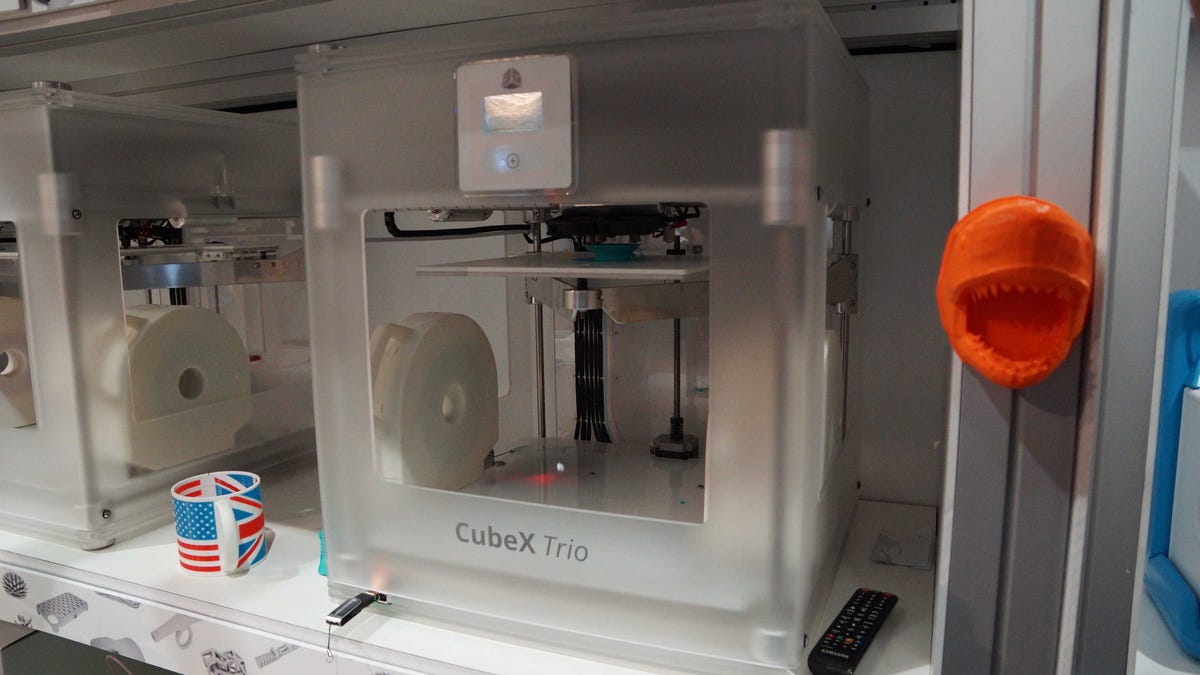Still emerging (for now): The 3D printers of CES 2013
While still not a mainstream consumer technology, 3D printers had an exciting presence on the CES show floor.

LAS VEGAS--No 3D printer vendor had a cavernous booth at CES. Only MakerBot held a press conference, but it was only a low-key presentation on the show floor, not some over-produced auditorium-filler.
And yet, every time I walked by a booth owned by a 3D printer manufacturer, the crowds were there in force. People are clearly excited by 3D printing here, and they had a variety of examples to learn about at the show.
I checked in on all of the major 3D printing vendors here at the show. Here's what I saw.
3D Systems
3D Systems had a very strong showing at CES. The company introduced a refined version of its consumer-oriented
For offering up the apparently most powerful desktop 3D printer, 3D Systems and the CubeX will come away from Las Vegas with a Best of Show award in the Emerging Tech category. It might take a few years, but eventually 3D printers will no longer be emerging, and they might just merit a category of their own.
Afinia
This Minnesota-based vendor is a U.S. licensee of Chinese-held Delta Micro Factory. You may have seen Delta Micro's UP! printers sold in the U.S. via distributor PP3DP, but rather than just distributing the UP!, Afinia has taken the core design and bundled it into its H-Series 3D printers, which the company says have improved packaging and FCC-certified electronics.
Afinia's only major news for the show is that it has a new software update that brings the print resolution in the H-Series down to 150 microns. If you'd like to learn more about the $1,499 H-Series 3D printer, check out the company's Web site.
FormLabs
Kickstarter darling FormLabs didn't have any major CES announcements, but this is the second time I've seen its Form1 3D printer in person, and it impressed me just as much as when I saw it back in September during Maker Faire NY.
The Form1 not only looks well designed, it uses a process called stereolithography to make objects with detail and smoothness that's superior to those from the rest of the printers here that use fused-deposition modeling.
FormLabs has announced that it will begin shipping the Form1 to its first batch of Kickstarter funders in the next few months. The company's long-term prospects are less clear due to a pending lawsuit with 3D Systems, but if it can weather the legal storm, the Form1 could bring desktop 3D printing to a new level of professional-class object-making.
MakerBot
The best-known 3D printer manufacturer, MakerBot, announced its new
3D Systems CubeX had a dominant showing with the CubeX, stealing the thunder from MakerBot, whose original Replicator 3D printer was last year's Emerging Tech category winner. MakerBot has a lot of buzz and a knack for marketing, but you can expect competition will only become more fierce among these and other 3D printing vendors.
Stratasys
Along with 3D Systems, Stratasys is the other large, publicly-traded 3D printing company. Both vendors have operated on the commercial side of the industry, designing million-dollar machines that can print in ceramic, gold, titanium, and other more exotic materials.
Stratasys does not yet sell a consumer-level desktop 3D printer. The closest product might be its Mojo, a $10,000 product announced back in May. The Mojo was on display on the show floor, and while it certainly looks impressive, it also has the veneer of a professional-grade manufacturing product.
As major patent holders, Stratasys and 3D Systems in particular have the opportunity to drive consumer 3D printing forward. Whether they're willing to risk cannibalizing sales of their high-end offerings by bringing their tech down to a more affordable level is another question. And of course any one of the other printer companies, at CES or elsewhere, could force their hand by improving their own technology.
3D printing has a few years to go before it becomes a mainstream technology. Prices need to come down, the ease of use needs to improve, and consumers will also need a way to design their own objects without having to master CAD. As more companies enter this space, the likelihood of all those things happening gets better, of course. Expect consumer interest, and our coverage of 3D printers to increase this year, and in the years following.

